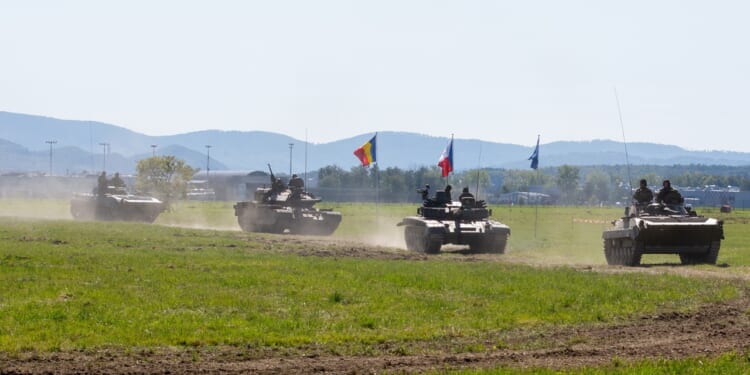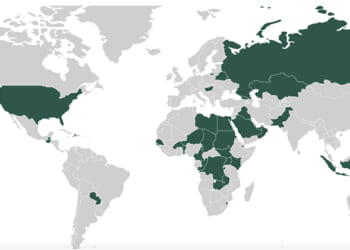Like all European NATO nations, Romania must do better at maintaining its military capabilities. But it must do so within the confines of what is economically realistic and logistically viable.
Following Romania’s most recent presidential election—in which NATO-skeptical candidate Cǎlin Georgescu was disqualified due to allegations of vote rigging and nefarious ties to Russia, and pro-NATO candidate Nicușor Dan won against his successor George Simion—NATO’s position in Romania has been secured, and its plans for expansion in that Eastern European nation can continue uninterrupted.
Romania is a NATO member sharing a border with Ukraine, in which NATO has grand designs to build a sprawling military facility along the Black Sea. And now there’s a new dimension to NATO’s military buildup. Romania has put forward a plan to purchase as many as 216 US-made M1A2 SEPv3 Abrams main battle tanks (MBTs).
These tanks will replace the aging Soviet-era platforms the Romanians had relied upon for decades. Among those Soviet platforms were antiquated systems like the Soviet T-55 MBT.
Romania’s Deal for New Abrams Tanks
According to The Defense Post, this multi-phase deal actually traces its roots back to a $1 billion agreement from 2023, when Romania had already approved the purchase of 54 modernized M1A2 SEPv3 Abrams plus 12 other vehicles based on the Abrams chassis that would support the operations of those new Abrams MBTs. That first tranche of Abrams MBTs is expected to be completed around 2028.
The second part of that 2023 deal involved equipping the Abrams battalion with the support infrastructure needed to maintain the iconic American MBT. This included ammunition, machine guns, spare parts, training systems, logistics, all of which was valued around $458 million.
But then came the big ask from Romania’s parliament after that initial deal had already been negotiated. Romania’s military was asking for a whopping 216 additional Abrams MBTs and another 76 support vehicles for those Abrams MBTs. The new deal was valued at €6.48 billion ($7.6 billion).
This second part of the proposed deal aligns with Romania’s aggressive expansion of NATO’s military capabilities in its territory, notably along the Black Sea. As part of the deal, Romania’s government wants what are known as “industrial cooperation measures” to ensure that Romania’s defense industrial base is given the tools and training to be more self-sustaining. In the event of a major European war, Romania could not necessarily access the US defense industrial base’s supply chain to maintain its fleet of new Abrams tanks. Accordingly, it wants to have these capabilities in-house.
If fully implemented, the deal will rapidly enhance Romania’s armored combat capability by bringing its heavy armor in line with modern NATO forces. Such a move will also ensure that Romania becomes the new logistics hub for NATO’s military capacity along the alliance’s Black Sea frontier with Russia—a key strategic maritime domain that Moscow has striven to dominate for centuries. Indeed, Russia’s designs on the Black Sea is one of the key reasons for the Ukraine War, as the initial disagreement between Moscow, Kyiv, and Brussels centered on whether Russia or Ukraine would control the vital port of Sevastopol on the Crimean Peninsula. Though Russia continued to lease the Port of Sevastopol from Ukraine, which inherited Crimea after the collapse of the Soviet Union, long-term frustrations about this arrangement—and a desire to reintegrate the mostly Russian-speaking Crimea into Russia—led Russia to invade and annex Crimea in 2014, kicking off a low-level conflict that led to the present war.
Romania’s Parliament has yet to finalize the expanded Abrams deal.
Can Romania Really Afford Dozens of Cutting-Edge Tanks?
The sheer cost of the deal is creating much financial pressure on Romania’s taxpayers—one reason for Georgescu’s unexpected early success in the last presidential election. There are concerns that the deal is so expensive that Romania, even if it pays for the tanks, will be unable to fulfill its obligations in maintaining those tanks. Romania is a member of the European Union (EU), too, and is therefore on the hook for an onerous Value-Added Tax (VAT) as part of the cost of importing the vehicles.
While the Romanians looked at other options for their much-needed MBT upgrade, such as the German Leopard 2A8 or South Korea’s K2 Black Panther, the Romanians apparently favor the costlier Abrams. In their view, it makes strategic sense, if only because it ties Romania closer to American supply chains. Ironically, that is likely one of the more negative aspects of the proposed deal—because the US defense industrial supply chain cannot maintain its own systems, let alone be expected to provide for other countries in the event of a conflict!
Nevertheless, Romanian leaders seem to believe that being directly reliant on the United States would make them better off if a war with Russia ever erupted along their border. This is the wrong decision. Like all European NATO nations, Romania must do better at maintaining its military capabilities. But it must do so within the confines of what is economically realistic and logistically viable.
About the Author: Brandon J. Weichert
Brandon J. Weichert is a senior national security editor at The National Interest. Recently, Weichert became the host of The National Security Hour on America Outloud News and iHeartRadio, where he discusses national security policy every Wednesday at 8pm Eastern. He is also a contributor at Popular Mechanics and has consulted regularly with various government institutions and private organizations on geopolitical issues. Weichert’s writings have appeared in multiple publications, including The Washington Times, National Review, The American Spectator, MSN, The Asia Times, and others. His books include Winning Space: How America Remains a Superpower, Biohacked: China’s Race to Control Life, and The Shadow War: Iran’s Quest for Supremacy. His newest book, A Disaster of Our Own Making: How the West Lost Ukraine is available for purchase wherever books are sold. He can be followed via Twitter @WeTheBrandon.
Image: Shutterstock / C-S.

















